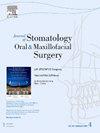Risk factors for postoperative recovery in oral cancer surgery: A retrospective cohort study
IF 1.8
3区 医学
Q2 DENTISTRY, ORAL SURGERY & MEDICINE
Journal of Stomatology Oral and Maxillofacial Surgery
Pub Date : 2024-09-11
DOI:10.1016/j.jormas.2024.102035
引用次数: 0
Abstract
Background
Effective management of oral cancer necessitates a multidisciplinary approach, with surgery playing a pivotal role in treatment. However, there are many risk factors during the perioperative period that affect postoperative recovery.
Purpose
This study aims to identify the risk factors influencing postoperative recovery in patients undergoing oral cancer surgery, thereby optimizing perioperative management.
Study design, setting, sample
A retrospective cohort study was carried out in patients who underwent surgery for oral cancer at The Second Affiliated Hospital Of Zhejiang University School Of Medicine from Jan. to Dec. in 2023. Based on the median length of stay (LOS) of 20.42 days, we divided the study population into DL3W and DM3W groups (DL3W/DM3W: Discharged less/>3 weeks).
Predictor variable
The Predictor variables included sex, age, BMI, smoke, drink, education, settlement, surgery history, tumor history, intra-operative situation, flap details, pathologic stage, treatment and laboratory examination.
Main outcome variable
The primary outcome was length of stay (LOS) defined as the days from the start of preoperative preparation to discharge from the hospital.
Analyses
Descriptive and inferential analyses were performed using the χ2 test, Fisher's exact test and t-test. A P value of 0.05 was deemed as an acceptable statistical significance level.
Results
The sample was composed of 103 subjects with a mean age of 59.45 (14.20) and 71 (68.9 %) were male. The median LOS was 20.42 ((range, 10–69) days. The baseline characteristics between the DL3W and DM3W groups were generally balanced. Factors associated with LOS were BMI (95 %CI 1.01–1.15, P = 0.046), intraoperative blood loss (95 %CI 0.;99–1.00, P = 0.002), flap source (P < 0.001), and postoperative fasting time (95 %CI 0.88–0.95, P < 0.001). In the regression model, more intraoperative blood loss and longer postoperative fasting time were associated with increased. LOS and factors BMI and the use of forearm flap were associated with decreased LOS after adjusting the confounding factors.
Conclusions and Relevance
In the perioperative period for oral cancer patients, optimizing postoperative recovery may be achieved by carefully managing BMI, intraoperative blood loss, flap source, and postoperative fasting time.
口腔癌手术术后恢复的风险因素:回顾性队列研究
有效治疗口腔癌需要采用多学科方法,其中手术在治疗中起着关键作用。然而,围手术期存在许多影响术后恢复的风险因素。本研究旨在确定影响口腔癌手术患者术后恢复的风险因素,从而优化围手术期管理。本研究对 2023 年 1 月至 12 月在浙江大学医学院附属第二医院接受口腔癌手术的患者进行了回顾性队列研究。根据中位住院时间(LOS)20.42天,我们将研究人群分为DL3W组和DM3W组(DL3W/DM3W:出院时间少于/>3周)。预测变量包括性别、年龄、体重指数、吸烟、饮酒、教育程度、定居、手术史、肿瘤史、术中情况、皮瓣细节、病理分期、治疗和实验室检查。主要结果是住院时间(LOS),即从术前准备开始到出院的天数。采用χ2检验、费雪精确检验和t检验进行描述性和推论性分析。P值为0.05为可接受的统计学显著性水平。样本由 103 名受试者组成,平均年龄为 59.45(14.20)岁,男性 71 人(68.9%)。平均住院日中位数为 20.42 天(10-69 天不等)。DL3W 组和 DM3W 组的基线特征基本平衡。与LOS相关的因素有体重指数(95 %CI 1.01-1.15, = 0.046)、术中失血量(95 %CI 0.;99-1.00, = 0.002)、皮瓣来源(< 0.001)和术后禁食时间(95 %CI 0.88-0.95, < 0.001)。在回归模型中,术中失血更多和术后禁食时间更长与手术时间延长有关。在调整了混杂因素后,LOS 和 BMI 及使用前臂皮瓣等因素与 LOS 的降低有关。在口腔癌患者围手术期,可以通过仔细管理体重指数、术中失血量、皮瓣来源和术后禁食时间来优化术后恢复。
本文章由计算机程序翻译,如有差异,请以英文原文为准。
求助全文
约1分钟内获得全文
求助全文
来源期刊

Journal of Stomatology Oral and Maxillofacial Surgery
Surgery, Dentistry, Oral Surgery and Medicine, Otorhinolaryngology and Facial Plastic Surgery
CiteScore
2.30
自引率
9.10%
发文量
0
审稿时长
23 days
 求助内容:
求助内容: 应助结果提醒方式:
应助结果提醒方式:


